Influences of Summer Precipitation Occurrence Time on Raindrop Spectrum Characteristics over the Northeastern Tibetan Plateau
Abstract
1. Introduction
2. Data and Methods
2.1. Data and Observation Instruments
2.2. Terminologies and Methods
3. Results
3.1. Raindrop Size Distribution Characteristics
3.2. Distribution Parameters
3.3. Distributions of lgNw and Dm
3.4. Distributions of Dm and R
3.5. Pre-Precipitation Characteristics
4. Conclusions
Supplementary Materials
Author Contributions
Funding
Institutional Review Board Statement
Informed Consent Statement
Data Availability Statement
Conflicts of Interest
References
- Yanai, M.; Li, C. Mechanism of heating and the boundary layer over the Tibetan Plateau. Mon. Wea. Rev. 1994, 122, 305–323. [Google Scholar]
- Ueno, K.; Fujii, H.; Yamada, H.; Liu, L. Weak and frequent monsoon precipitation over the Tibetan Plateau. J. Meteorol. Soc. Japan. Ser. II 2001, 79, 419–434. [Google Scholar] [CrossRef]
- Cheng, Q.; Gao, L.; Zuo, X.; Zhong, F. Statistical analyses of spatial and temporal variabilities in total, daytime, and nighttime precipitation indices and of extreme dry/wet association with large-scale circulations of southwest China, 1961–2016. Atmos. Res. 2019, 219, 166–182. [Google Scholar] [CrossRef]
- Fujinami, H.; Yasunari, T. The seasonal and intraseasonal variability of diurnal cloud activity over the Tibetan Plateau. J. Meteorol. Soc. Japan. Ser. II 2001, 79, 1207–1227. [Google Scholar] [CrossRef]
- Zhou, C.; Wang, K. Contrasting daytime and nighttime precipitation variability between observations and eight reanalysis products from 1979 to 2014 in China. J. Clim. 2017, 30, 6443–6464. [Google Scholar] [CrossRef]
- Feng, S.; Fu, Y.; Xiao, Q. Is the tropopause higher over the Tibetan Plateau? observational evidence from constellation observing system for meteorology, ionosphere, and climate (cosmic) data. J. Geophys. Res. Atmos. 2011, 116, D21121. [Google Scholar] [CrossRef]
- Yu, R.; Zhou, T.; Xiong, A.; Zhu, Y.; Li, J. Diurnal variations of summer precipitation over contiguous China. Geophys. Res. Lett. 2007, 34. [Google Scholar] [CrossRef]
- Sugimoto, S.; Ueno, K. Formation of mesoscale convective systems over the eastern Tibetan Plateau affected by plateau-scale heating contrasts. J. Geophys. Res. Atmos. 2010, 115, D16. [Google Scholar] [CrossRef]
- Barros, A.P.; Kim, G.; Williams, E.; Nesbitt, S.W. Probing orographic controls in the Himalayas during the monsoon using satellite imagery. Nat. Hazards Earth Syst. Sci. 2004, 4, 29–51. [Google Scholar] [CrossRef]
- Fu, Y.; Liu, G.; Wu, G.; Yu, R.; Xu, Y.; Wang, Y.; Li, R.; Liu, Q. Tower mast of precipitation over the central Tibetan Plateau summer. Geophys. Res. Let. 2006, 33, L05802. [Google Scholar] [CrossRef]
- Uyeda, H.; Yamada, H.; Horikomi, J.; Shirooka, R.; Shimizu, S.; Liping, L.; Ueno, K.; Fujii, H.; Koike, T. Characteristics of convective clouds observed by a doppler radar at Naqu on Tibetan Plateau during the GAME-Tibet IOP. J. Meteorol. Soc. Japan. Ser. II 2001, 79, 463–474. [Google Scholar] [CrossRef]
- Fujinami, H.; Nomura, S.; Yasunari, T. Characteristics of Diurnal Variations in Convection and Precipitation over the Southern Tibetan Plateau during Summer. SOLA 2005, 1, 49–52. [Google Scholar] [CrossRef]
- You, Q.; Kang, S.; Aguilar, E.; Yan, Y. Changes in daily climate extremes in the eastern and central Tibetan Plateau during 1961–2005. J. Geophys. Res. Atmos. 2008, 113, D7. [Google Scholar] [CrossRef]
- Zeng, C.; Zhang, F.; Wang, L.; Chen, D. Summer precipitation characteristics on the southern Tibetan Plateau. Int. J. Climatol. 2021, 41, E3160–E3177. [Google Scholar] [CrossRef]
- Sugimoto, S.; Ueno, K.; Sha, W. Transportation of water vapor into the Tibetan Plateau in the case of a passing synoptic-scale trough. J. Meteorol. Soc. Japan. Ser. II 2008, 86, 935–949. [Google Scholar] [CrossRef]
- Li, Y.; Yu, R.; Xu, Y.; Zhang, X. Spatial distribution and seasonal variation of cloud over china based on isccp data and surface observations. J. Meteorol. Soc. Japan. Ser. II 2004, 82, 761–773. [Google Scholar] [CrossRef]
- Ueno, K.; Takano, S.; Kusaka, H. Nighttime precipitation induced by a synoptic-scale convergence in the central Tibetan Plateau. J. Meteorol. Soc. Japan. Ser. II 2009, 87, 459–472. [Google Scholar] [CrossRef]
- Shimizu, S.; Ueno, K.; Fujii, H.; Yamada, H.; Shirooka, R.; Liu, L. Mesoscale characteristics and structures of stratiform precipitation on the Tibetan Plateau. J. Meteorol. Soc. Japan. Ser. II 2001, 79, 435–461. [Google Scholar] [CrossRef]
- Nitta, T. Observational Study of Heat Sources Over the Eastern Tibetan Plateau during the Summer Monsoon. J. Meteorol. Soc. Japan. Ser. II 1983, 61, 590–605. [Google Scholar] [CrossRef][Green Version]
- Liu, L.P.; Feng, J.M.; Rong, Z.C.; Yun, J.Z.; Ueno, K. The diurnal variation of precipitation in monsoon season in the Tibetan Plateau. Adv. Atmos. Sci. 2002, 19, 365–378. [Google Scholar][Green Version]
- Bringi, V.N.; Chandrasekar, V.; Hubbert, J.; Gorgucci, E.; Randeu, W.L.; Schoenhuber, M. Raindrop size distribution in different climatic regimes from disdrometer and dual-polarized radar analysis. J. Atmos. Sci. 2003, 60, 354–365. [Google Scholar] [CrossRef]
- Jia, X.; Liu, Y.; Ding, D.; Ma, X.; Chen, Y.; Bi, K.; Tian, P.; Lu, C.; Quan, J. Combining disdrometer, microscopic photography, and cloud radar to study distributions of hydrometeor types, size and fall velocity. Atmos. Res. 2019, 228, 176–185. [Google Scholar] [CrossRef]
- Miriovsky, B.J.; Bradley, A.A.; Eichinger, W.E.; Krajewski, W.F.; Kruger, A.; Nelson, B.R.; Creutin, J.D.; Lapetite, J.M.; Lee, W.G.; Zawadzkj, T.; et al. An Experimental Study of Small-Scale Variability of Radar Reflectivity Using Disdrometer Observations. J. App. Meteorol. 2004, 43, 106–118. [Google Scholar] [CrossRef]
- Lyu, J.J.; Xiao, H.W.; Du, Y.C.; Sha, L.; Deng, Y.Q.; Jia, W.K.; Niu, S.J.; Zhou, Y.; Pang, G.Q. Variations of raindrop size distribution and radar retrieval in outer rainbands of Typhoon Mangkhut (2018). J. Meteor. Res. 2022, 36, 500–519. [Google Scholar] [CrossRef]
- Wen, L.; Zhao, K.; Wang, M.; Zhang, G. Seasonal Variations of Observed Raindrop Size Distribution in East China. Adv. Atmos. Sci. 2019, 36, 346–362. [Google Scholar] [CrossRef]
- Tang, Q.; Xiao, H.; Guo, C.; Feng, L. Characteristics of the raindrop size distributions and their retrieved polarimetric radar parameters in northern and southern China. Atmos. Res. 2014, 135–136, 59–75. [Google Scholar] [CrossRef]
- Niu, S.; Jia, X.; Sang, J.; Liu, X.; Lu, C.; Liu, Y. Distributions of Raindrop Sizes and Fall Velocities in a Semiarid Plateau Climate: Convective versus Stratiform Rains. J. Appl. Meteorol. Climatol. 2010, 49, 632–645. [Google Scholar] [CrossRef]
- Wu, Z.; Zhang, Y.; Zhang, L.; Lei, H.; Xie, Y.; Wen, L.; Yang, J. Characteristics of summer season raindrop size distribution in three typical regions of western Pacific. J. Geophys. Res. Atmos. 2019, 124, 4054–4073. [Google Scholar] [CrossRef]
- Li, Q.; Wei, J.; Yin, J.; Qiao, Z.; Cao, J.; Shi, Y. Microphysical characteristics of raindrop size distribution and implications for radar rainfall estimation over the northeastern Tibetan Plateau. J. Geophys. Res. Atmos. 2022, 127, e2021JD035575. [Google Scholar] [CrossRef]
- Chen, B.; Hu, Z.; Liu, L.; Zhang, G. Raindrop Size Distribution Measurements at 4500 m on the Tibetan Plateau During TIPEX-III. J. Geophys. Res. Atmos. 2017, 122, 11,092–11,106. [Google Scholar] [CrossRef]
- Porcù, F.; D’ Adderio, L.P.; Prodi, F.; Caracciolo, C. Rain drop size distribution over the Tibetan Plateau. Atmos. Res. 2014, 150, 21–30. [Google Scholar] [CrossRef]
- Wang, Y.; Zheng, J.; Cheng, Z.; Wang, B. Characteristics of raindrop size distribution on the eastern slope of the Tibetan Plateau in summer. Atmosphere 2020, 11, 562. [Google Scholar] [CrossRef]
- Yuter, S.E.; Kingsmill, D.E.; Nance, L.B.; Löffler-Mang, M. Observations of Precipitation Size and Fall Speed Characteristics within Coexisting Rain and Wet Snow. J. App. Meteorol. Clim. 2006, 45, 1450–1464. [Google Scholar] [CrossRef]
- Battaglia, A.; Rustemeier, E.; Tokay, A.; Blahak, U.; Simmer, C. Parsivel snow observations: A critical assessment. Atmos. Ocean. Technol. 2010, 27, 333–344. [Google Scholar] [CrossRef]
- Marshall, J.S.; Palmer, W.M. The distribution of rain drops with size. J. Meteorol. 1948, 5, 165–166. [Google Scholar] [CrossRef]
- Vivekanandan, J.; Zhang, G.; Brandes, E. Polarimetric Radar Estimators Based on a Constrained Gamma Drop Size Distribution Model. J. Appl. Meteorol. Climatol. 2004, 43, 217–230. [Google Scholar] [CrossRef]
- Ulbrich, C.W. Natural Variations in the Analytical Form of the Raindrop Size Distribution. J. Clim. Appl. Meteorol. 1983, 22, 1764–1775. [Google Scholar] [CrossRef]
- Lü, J.J.; Zhou, Y.; Fu, Z.K.; Lu, C.S.; Huang, Q.; Sun, J.; Zhao, Y.; Niu, S.J. Variability of raindrop size distribution during a regional freezing rain event in the Jianghan Plain of central China. Adv. Atmos. Sci. 2023, 40, 725–742. [Google Scholar] [CrossRef]
- Chen, B.; Yang, J.; Pu, J. Statistical Characteristics of Raindrop Size Distribution in the Meiyu Season Observed in Eastern China. J. Meteorol. Soc. Japan. Ser. II 2013, 91, 215–227. [Google Scholar] [CrossRef]
- Fu, Z.; Dong, X.; Zhou, L.; Cui, W.; Wang, J.; Wan, R.; Liang, L.; Xi, B. Statistical Characteristics of Raindrop Size Distributions and Parameters in Central China During the Meiyu Seasons. J. Geophys. Res. Atmos. 2020, 125, e2019JD031954. [Google Scholar] [CrossRef]
- Han, H.B.; Zhang, Y.X.; Tian, J.B.; Kang, X.Y. Raindrop size distribution measurements at high altitudes in the Northeastern Tibetan Plateau during summer. Adv. Atmos. Sci. 2023, 40, 1244–1256. [Google Scholar] [CrossRef]
- Hu, Z.; Srivastava, R.C. Evolution of Raindrop Size Distribution by Coalescence, Breakup, and Evaporation: Theory and Observations. J. Atmos. Sci. 1995, 52, 1761–1783. [Google Scholar] [CrossRef]
- Feng, L.; Zhou, T. Water vapor transport for summer precipitation over the Tibetan Plateau: Multidata set analysis. J. Geophys. Res. Atmos. 2012, 117, D20114. [Google Scholar] [CrossRef]
- Taichi Sasaki, T.; Wu, P.; Kimura, F.; Yoshikane, T.; Liu, J. Drastic Evening Increase in Precipitable Water Vapor over the Southeastern Tibetan Plateau. J. Meteorol. Soc. Japan. Ser. II 2003, 81, 1273–1281. [Google Scholar] [CrossRef]
- Lin, X.; Randall, D.A.; Fowler, L.D. Diurnal Variability of the Hydrologic Cycle and Radiative Fluxes: Comparisons between Observations and a GCM. J. Clim. 2000, 13, 4159–4179. [Google Scholar] [CrossRef]


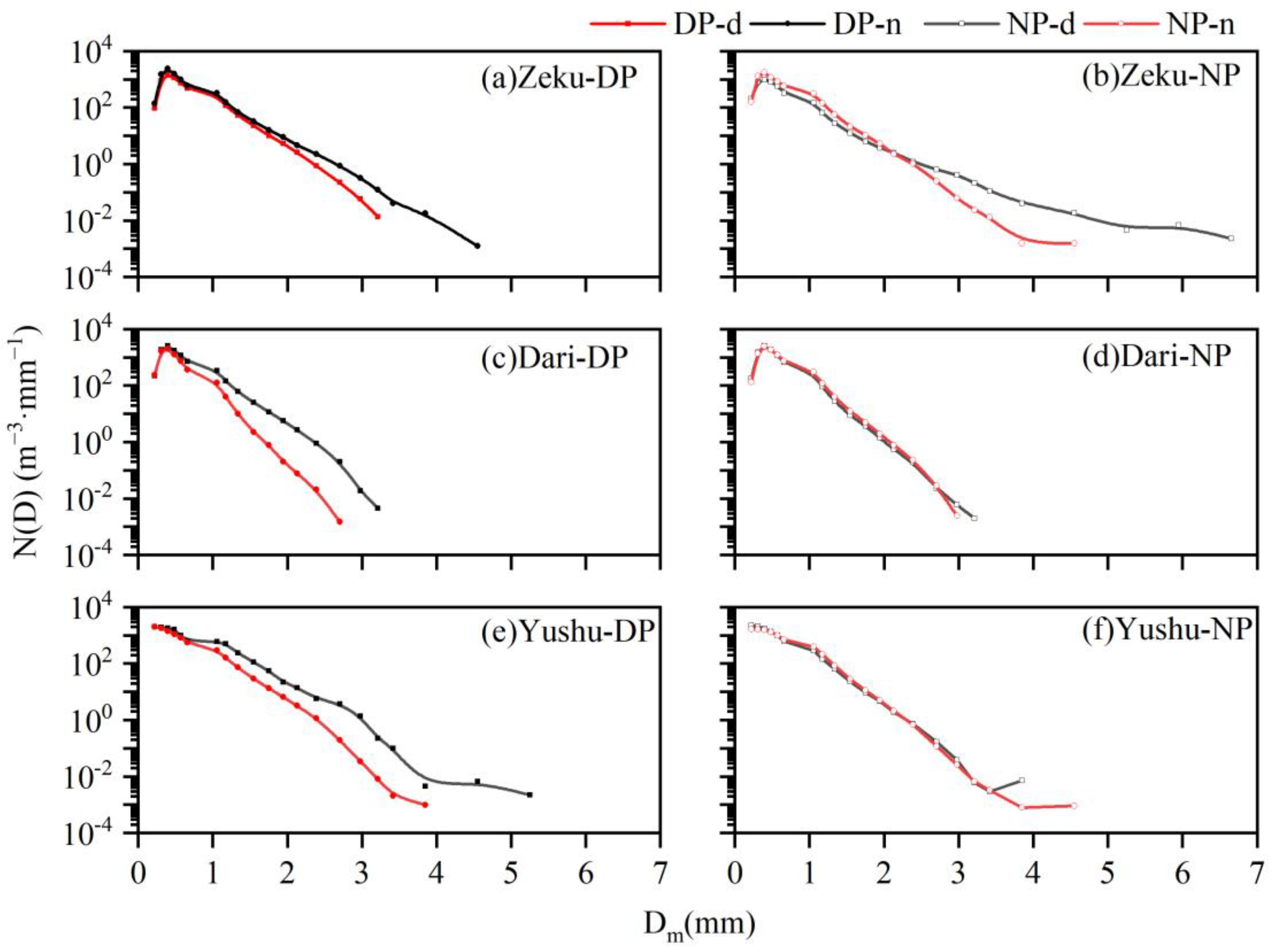
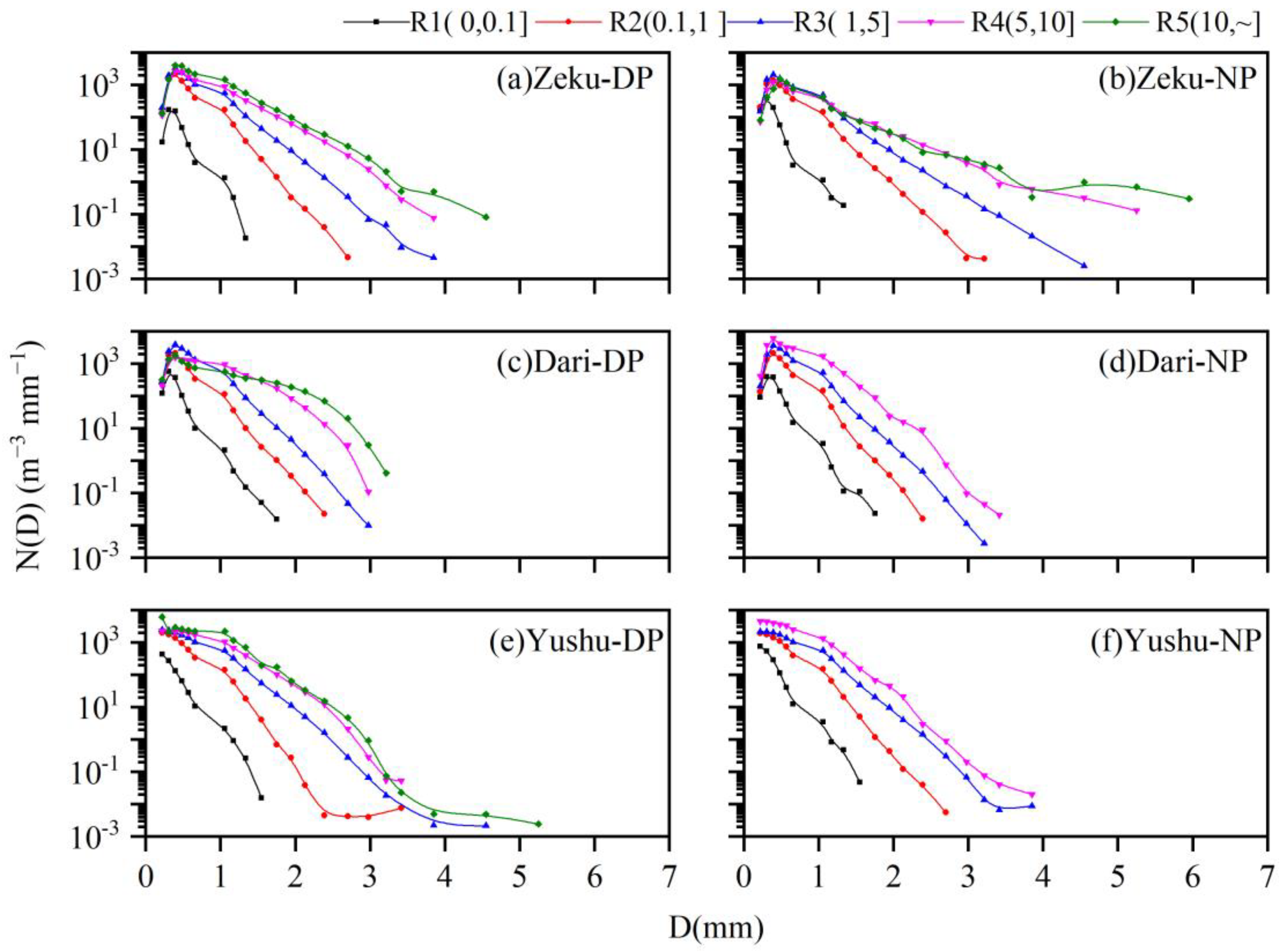

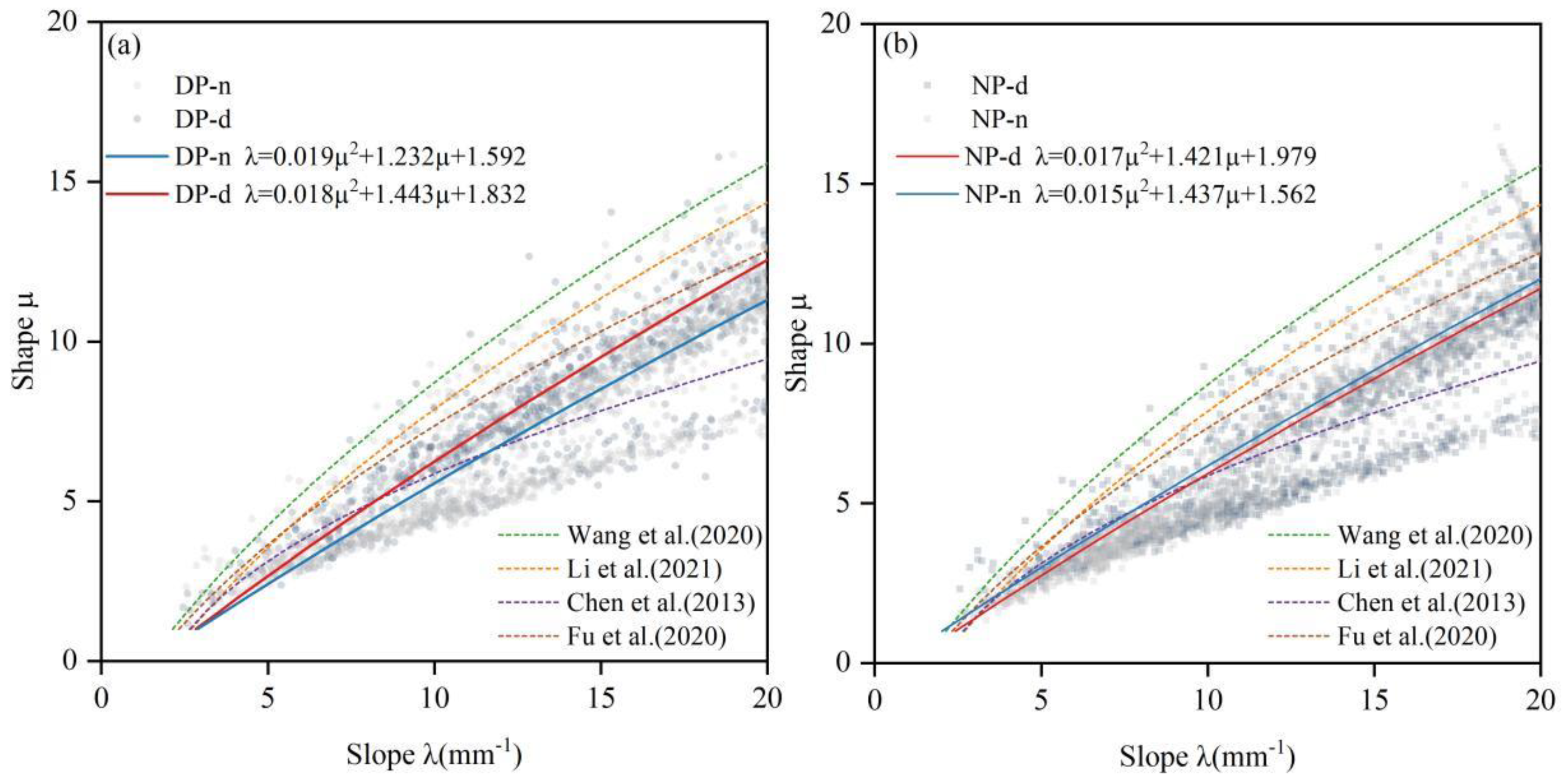
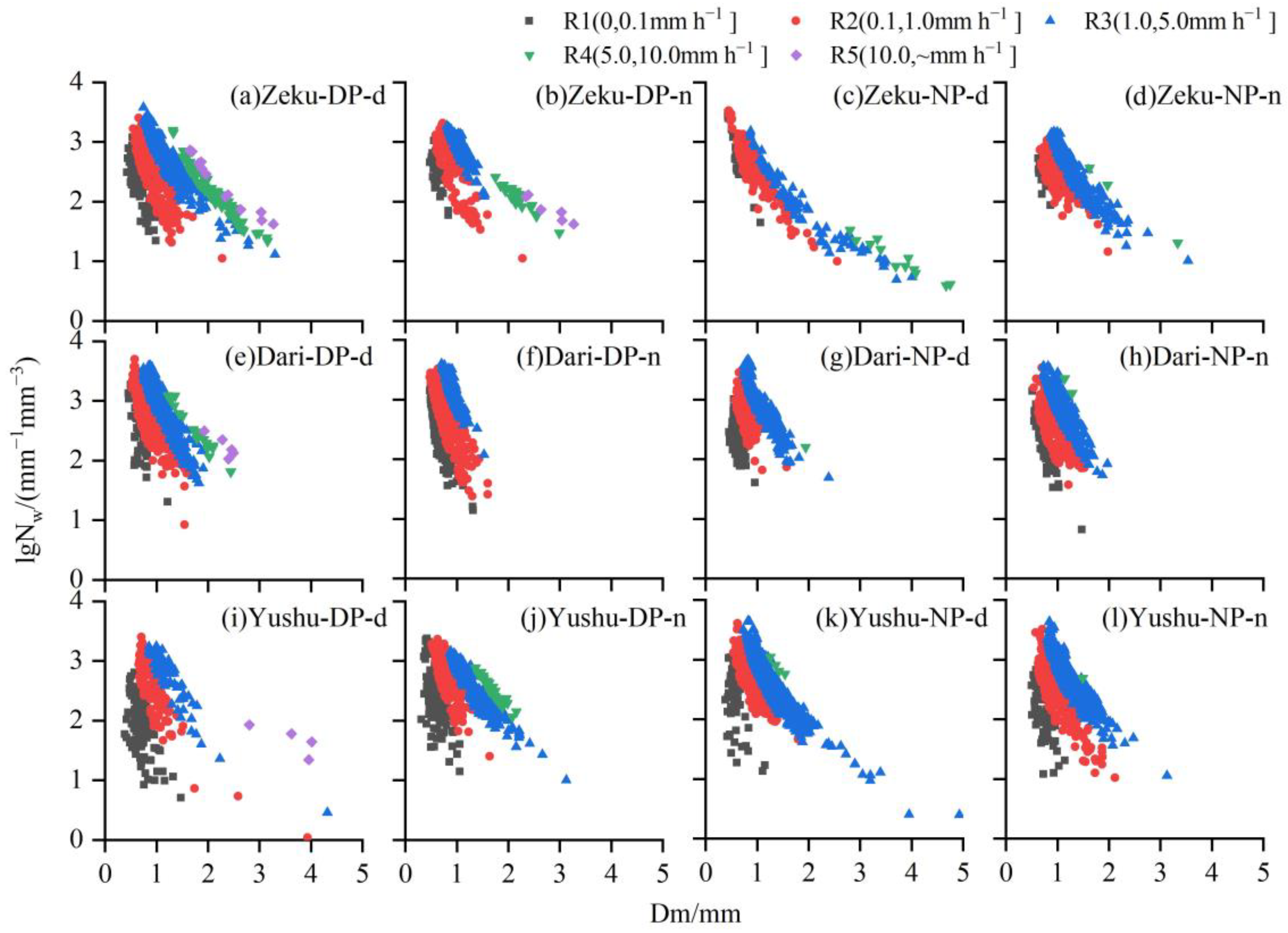
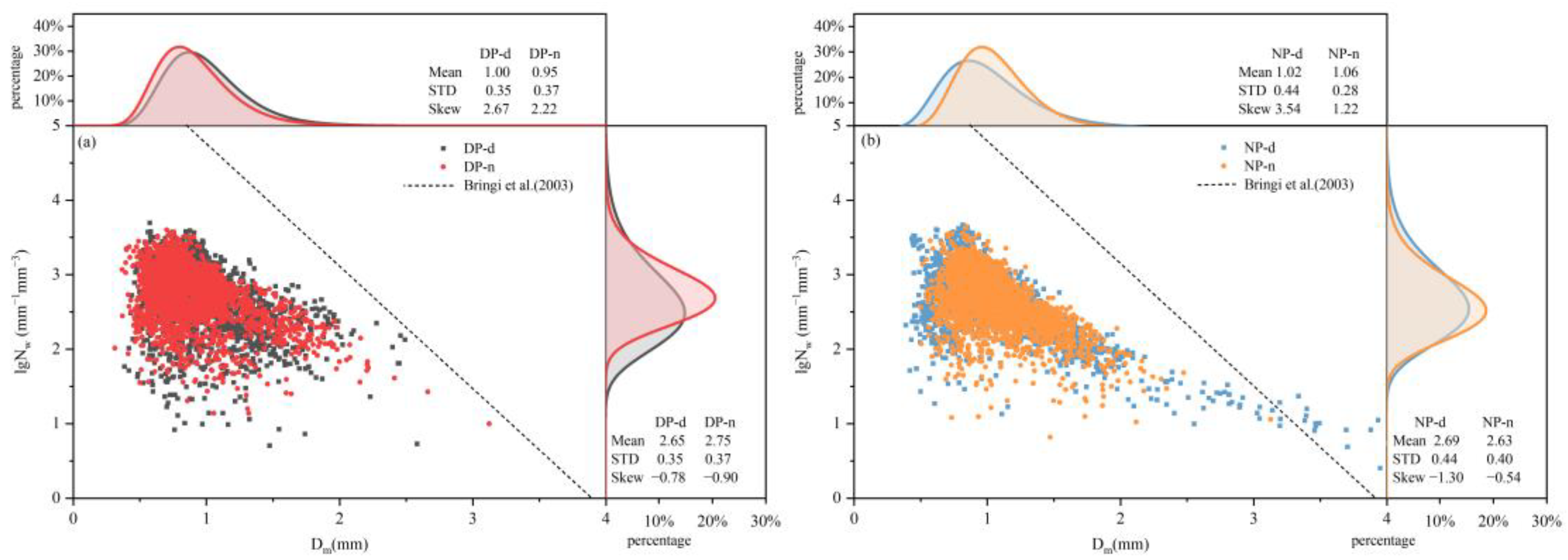



| Location | Altitude (m) | Date | DP | NP |
|---|---|---|---|---|
| Number of Samples | Number of Samples | |||
| Zeku | 3663 | August 2019–October 2019, May 2020–June 2020 | 1414 | 1505 |
| Dari | 3967 | June 2018–October 2018 | 2500 | 1964 |
| Yushu | 4290 | May 2014–September 2014 | 1451 | 2617 |
| Location | Rain Type | R (mm·h−1) | N(D) (m−3·mm−1) | Dm (mm) | W (mg·m−3) |
|---|---|---|---|---|---|
| Zeku | DP | 1.29 | 2233.70 | 3.06 | 0.08 |
| NP | 1.34 | 2810.30 | 3.64 | 0.06 | |
| Dari | DP | 0.77 | 2442.90 | 3.52 | 0.06 |
| NP | 0.92 | 2763.60 | 3.67 | 0.07 | |
| Yushu | DP | 1.06 | 2366.00 | 3.12 | 0.07 |
| NP | 1.18 | 3029.50 | 3.69 | 0.08 | |
| Total | 1.10 | 2607.67 | 3.45 | 0.07 | |
Disclaimer/Publisher’s Note: The statements, opinions and data contained in all publications are solely those of the individual author(s) and contributor(s) and not of MDPI and/or the editor(s). MDPI and/or the editor(s) disclaim responsibility for any injury to people or property resulting from any ideas, methods, instructions or products referred to in the content. |
© 2023 by the authors. Licensee MDPI, Basel, Switzerland. This article is an open access article distributed under the terms and conditions of the Creative Commons Attribution (CC BY) license (https://creativecommons.org/licenses/by/4.0/).
Share and Cite
Zhang, Y.; Han, H.; Zhang, B.; Hou, Y. Influences of Summer Precipitation Occurrence Time on Raindrop Spectrum Characteristics over the Northeastern Tibetan Plateau. Atmosphere 2024, 15, 41. https://doi.org/10.3390/atmos15010041
Zhang Y, Han H, Zhang B, Hou Y. Influences of Summer Precipitation Occurrence Time on Raindrop Spectrum Characteristics over the Northeastern Tibetan Plateau. Atmosphere. 2024; 15(1):41. https://doi.org/10.3390/atmos15010041
Chicago/Turabian StyleZhang, Yuxin, Huibang Han, Boyue Zhang, and Yonghui Hou. 2024. "Influences of Summer Precipitation Occurrence Time on Raindrop Spectrum Characteristics over the Northeastern Tibetan Plateau" Atmosphere 15, no. 1: 41. https://doi.org/10.3390/atmos15010041
APA StyleZhang, Y., Han, H., Zhang, B., & Hou, Y. (2024). Influences of Summer Precipitation Occurrence Time on Raindrop Spectrum Characteristics over the Northeastern Tibetan Plateau. Atmosphere, 15(1), 41. https://doi.org/10.3390/atmos15010041





